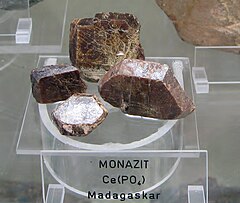Monazite
| Monazite | |
|---|---|
 |
|
| General | |
| Category | Phosphate minerals |
|
Formula (repeating unit) |
(Ce,La)PO4 |
| Strunz classification | 8.AD.50 |
| Crystal system | Monoclinic |
| Crystal class | Prismatic (2/m) (same H-M symbol) |
| Space group | P21/n |
| Identification | |
| Color | Reddish brown, brown, pale yellow, pink, green, gray |
| Crystal habit | Commonly as prismatic or wedge-shaped crystals |
| Twinning | Contact twins common |
| Cleavage | Distinct on [100] poor on [010] |
| Fracture | Conchoidal to uneven |
| Mohs scale hardness | 5.0 to 5.5 |
| Luster | Resinous, vitreous to adamantine |
| Streak | White |
| Diaphaneity | Translucent to opaque |
| Specific gravity | 4.6–5.7 (4.98–5.43 for Monazite-Ce) |
| Optical properties | Biaxial (+) |
| Refractive index | nα = 1.770–1.793 nβ = 1.778–1.800 nγ = 1.823–1.860 |
| Pleochroism | Weak |
| 2V angle | 10–26° |
| Other characteristics | Radioactive if thorium-rich, dull brown cathodoluminescence, paramagnetic |
| References | |
Monazite is a reddish-brown phosphate mineral containing rare earth metals. It occurs usually in small isolated crystals. It has a hardness of 5.0 to 5.5 on the Mohs scale of mineral hardness and is relatively dense, about 4.6 to 5.7 g/cm3. There are at least four different kinds of monazite, depending on relative elemental composition of the mineral:
The elements in parentheses are listed in the order of their relative proportion within the mineral: lanthanum is the most common rare earth element in monazite-(La), and so forth. Silica (SiO2) is present in trace amounts, as well as small amounts of uranium and thorium. Due to the alpha decay of thorium and uranium, monazite contains a significant amount of helium, which can be extracted by heating.
Monazite is an important ore for thorium, lanthanum, and cerium. It is often found in placer deposits. India, Madagascar, and South Africa have large deposits of monazite sands. The deposits in India are particularly rich in monazite.
Monazite is radioactive due to the presence of thorium and, less commonly, uranium. Because of its radioactive nature, monazite is used for monazite geochronology to study geological events, such as crystallization, heating, or deformation of the rocks containing monazite.
The name monazite comes from the Greek μονάζειν (to be solitary), via German Monazit, in allusion to its isolated crystals.
All monazites adopt the same structure, meaning that the connectivity of the atoms is very similar to other compounds of the type M(III)PO4. The M(III) centers have a distorted coordination sphere being surrounded by eight oxides with M-O distances around 2.6 Å in length. The phosphate anion is tetrahedral, as usual. The same structural motif is observed for lead chromate (PbCrO4).
...
Wikipedia
